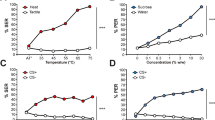Summary
Differential conditioning of the proboscis extension reflex in honeybees is used to assess whether worker honeybees can be trained to discriminate between volatile odors emanating from different kin groups consisting of 2 or 20 workers. These odor source group workers are all reared and maintained under identical environmental conditions. They are the progeny of a queen that has been instrumentally inseminated so that eclosing adult workers can be sorted into colormorph full sister patrilines (workers are half sisters across patrilines). We demonstrate that workers are able to discriminate between the odors from groups of 20 individuals only if the groups represent individuals from different patrilines. However, discrimination occurs between groups of 2 individuals even if groups do not represent different patrilines. A number of environmental control experiments are also conducted. From our results we infer that there is heritable variation in the production of volatile odors by worker honeybees at a level that can be detected by the workers.
Similar content being viewed by others
References
Beecher IM, Beecher MD (1983) Sibling recognition in bank swallows (Riparia riparia) Z Tierpsychol 62:145–150
Bermant G, Gary NE (1966) Discrimination training and reversal in groups of honey bees. Psychon Sci 5:179–180
Bitterman ME, Menzel R, Fietz A, Schäfer S (1983) Classical conditioning of proboscis extension in honeybees (Apis mellifera). J Comp Psychol 97:107–119
Boch R, Morse RA (1982) Genetic factor in queen recognition odors of honey bees. Ann Entomol Soc Am 75:654–656
Breed MD (1983) Nestmate recognition in honey bees. Anim Behav 31:86–91
Breed MD, Butler L, Stiller TM (1985) Kin discrimination by worker honey bees in genetically mixed groups. Proc Natl Acad Sci USA 82:3058–3061
Buckle GR, Greenberg L (1981) Nestmate recognition in sweat bees (Lasioglossum zephyrum): does an individual recognize its own odour or only the odours of its nestmates? Anim Behav 29:802–809
Carlin NF, Hölldobler B (1983) Nestmate and kin recognition in interspecific mixed colonies of ants. Science 222:1027–1029
Crozier RH, Dix MW (1979) Analysis of two genetic models for the innate components of colony odor in social Hymenoptera. Behav Ecol Sociobiol 4:217–224
Frisch K von (1965) Tanzsprache und Orientierung der Bienen. Springer, Berlin Heidelberg New York
Gamboa GJ, Reeve HK, Ferguson ID, Wacker TL (in press) Nestmate recognition in social wasps: the origin and acquisition of recognition odours. Anim Behav
Getz WM (1981) Genetically based kin recognition systems. J Theor Biol 92:209–226
Getz WM (1982) An analysis of learned kin recognition in Hymenoptera. J Theor Biol 99:585–597
Getz WM, Smith KB (1983) Genetic kin recognition: honey bees discriminate between full and half-sisters. Nature 302:147–148
Getz WM, Smith KB (in press) Honey bee kin recognition: learning self and nestmate phenotypes. Anim Behav
Greenberg L (1979) Genetic component of bee odor in kin recognition. Science 206:1095–1097
Hölldobler B, Michener CD (1980) Mechanisms of identification and discrimination in social Hymenoptera. Dahlem Konferenzen, Evolution of Social Behavior: 35–58
Holmes WG (1984) Sibling recognition in thirteen-lined ground squirrels: effects of genetic relatedness, rearing association, and olfaction. Behav Ecol Sociobiol 14:225–233
Kalmus H, Ribbands CR (1952) The origin of the odours by which honeybees distinguish their companions. Proc R Soc Lond Ser B 140:50–59
Kukuk PF, Breed MB, Sobti A, Bell WJ (1977) The contributions of kinship and conditioning to nestmate recognition and colony member recognition in a primitively eusocial beeLasioglossum zephyrum (Hymenoptera: Halictidae). Behav Ecol Sociobiol 2:319–327
Lacy RC, Sherman PW (1983) Kin recognition by phenotype matching. Am Naturalist 121:489–512
Linsenmair KE (1985) Individual and family recognition in subsocial arthropods, in particular in the desert isopodHemilepistus reamuri. In: Hölldobler B, Lindauer M (eds) Experimental behavioral ecology and sociobiology. Sinauer Associates, Sunderland, pp 411–436
Menzel R, Erber J, Masuhr T (1974) Learning and memory in the honeybee. In: Browne LB (ed) Experimental analysis of insect behaviour. Springer, Berlin Heidelberg New York, pp 195–217
Mintzer A, Vinson SB (1985) Kinship and incompatibility between colonies of the acacia antPseudomyrmex ferruginea. Behav Ecol Sociobiol 17:75–78
Porter RH, Wyrick M, Pankey J (1978) Sibling recognition in spiny mice (Acomys cahirinus). Behav Ecol Sociobiol 3:61–68
Sachs L (1982) Applied statistics: a handbook of techniques. Springer, Berlin Heidelberg New York
Smith B (1983) Recognition of female kin by male bees through olfactory signals. Proc Natl Acad Sci USA 80:4551–4553
Vareschi E (1971) Duftunterscheidung bei der Honigbiene. Einzelzell-Ableitungen und Verhaltensreaktionen. Z Vergl Physiol 75:143–173
Waldman B (1985) Olfactory basis of kin recognition in toad tadpoles. J Comp Physiol A 156:565–597
Wills GD, Wesley AL, Sisenmore DA, Anderson HN, Banks LM (1983) Discrimination by olfactory cues in albino rats reflecting familiarity and relatedness among conspecifics. Behav Neural Biol 38:139–143
Wu HMN, Holmes WG, Medina SR, Sackett GP (1980) Kin preference in infantMacaca nemestrina. Nature 285:225–227
Author information
Authors and Affiliations
Rights and permissions
About this article
Cite this article
Getz, W.M., Brückner, D. & Smith, K.B. Conditioning honeybees to discriminate between heritable odors from full and half sisters. J. Comp. Physiol. 159, 251–256 (1986). https://doi.org/10.1007/BF00612307
Accepted:
Issue Date:
DOI: https://doi.org/10.1007/BF00612307




